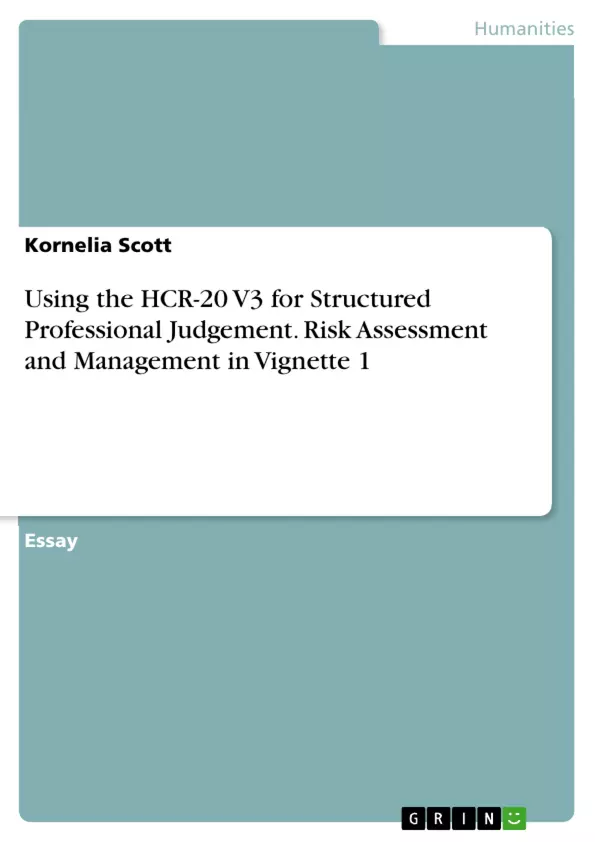This assignment applies the HCR-20 V3 Structured Professional Judgement (SPJ) tool to assess and manage future risk in Vignette 1. The HCR-20 V3 is selected due to its comprehensive approach to violence risk assessment, integrating historical, clinical, and risk management factors. The selection and application of this tool are critically appraised with reference to the relevant literature, focusing on its validity, reliability, and utility in professional settings.
Key findings and recommendations are provided regarding the level of risk, treatment needs, and risk management strategies for the individual in Vignette 1. An evidence grid, outlining specific details for each item in the HCR-20 V3, is included in the appendix to ensure transparency and accountability in the risk assessment process.
Inhaltsverzeichnis (Table of Contents)
- Part 1: Suitability and Critical Appraisal of the HCR-20 V3
- Part 2: Risk Assessment of Mr. Black
Zielsetzung und Themenschwerpunkte (Objectives and Key Themes)
This essay aims to critically appraise the suitability of the HCR-20 V3 risk assessment tool for evaluating the risk of violence posed by Mr. Black, a 44-year-old male with a history of violent offenses. It then assesses Mr. Black's risk, need for treatment, and potential risk mitigation strategies.
- Suitability of the HCR-20 V3 for assessing diverse forms of violence.
- Comparison of the HCR-20 V3 with other risk assessment tools.
- The importance of considering both static and dynamic risk factors.
- The role of risk assessment in parole board decisions.
- Development of a risk mitigation strategy for Mr. Black.
Zusammenfassung der Kapitel (Chapter Summaries)
Part 1: Suitability and Critical Appraisal of the HCR-20 V3: This section justifies the selection of the HCR-20 V3 risk assessment tool for analyzing Mr. Black's case. It begins by outlining the importance of accurate risk assessment in parole board hearings, emphasizing the balance between public protection and the rights of service users. The essay then differentiates between unstructured clinical judgment, structured professional judgment (SPJ), and actuarial tools, highlighting the HCR-20 V3's position as an SPJ instrument. The rationale for choosing the HCR-20 V3 is meticulously explained, emphasizing its comprehensive coverage of various violence types (general violence, intimate partner violence, and sexual violence) present in Mr. Black's history. The section also contrasts the HCR-20 V3 with other SPJ instruments like the RSVP and SARA, highlighting the HCR-20 V3's broader scope and inclusion of dynamic risk factors, which are crucial for assessing Mr. Black's recent positive behavioral changes. The section concludes by emphasizing the HCR-20 V3's unique features, such as formulation and scenario planning, which are particularly beneficial for risk management in parole contexts. The inclusion of dynamic scales allows for a nuanced assessment of Mr. Black's evolving situation, making the HCR-20 V3 a superior choice compared to actuarial tools that only consider static risk factors.
Schlüsselwörter (Keywords)
HCR-20 V3, risk assessment, structured professional judgment, violence risk, parole board, forensic psychology, risk management, dynamic risk factors, historical risk factors, intimate partner violence, sexual violence, risk mitigation.
Frequently asked questions
What is the purpose of this document?
This document is a language preview for an academic analysis of risk assessment, specifically focusing on the suitability and application of the HCR-20 V3 tool. It includes a table of contents, objectives, key themes, chapter summaries, and keywords.
What is the HCR-20 V3?
The HCR-20 V3 is a risk assessment tool used in forensic psychology to evaluate the likelihood of violence. It is a structured professional judgment (SPJ) instrument.
What are the main objectives and key themes discussed?
The main objective is to critically appraise the HCR-20 V3's suitability for assessing the risk of violence posed by Mr. Black. Key themes include the suitability of the HCR-20 V3 for assessing various forms of violence, comparing it with other risk assessment tools, the importance of considering static and dynamic risk factors, the role of risk assessment in parole board decisions, and developing a risk mitigation strategy.
What is covered in Part 1 of the essay?
Part 1 focuses on justifying the selection of the HCR-20 V3 for analyzing Mr. Black's case. It explains the importance of accurate risk assessment, differentiates between unstructured clinical judgment, SPJ, and actuarial tools, and explains why the HCR-20 V3 was chosen over other tools like the RSVP and SARA. It highlights the HCR-20 V3’s broader scope and dynamic scales.
Who is Mr. Black?
Mr. Black is a 44-year-old male with a history of violent offenses whose risk of violence is being assessed using the HCR-20 V3 tool.
What are static and dynamic risk factors?
Static risk factors are unchanging historical factors, while dynamic risk factors are factors that can change over time, such as behavior and attitudes. The HCR-20 V3 considers both.
Why is the HCR-20 V3 considered a superior choice compared to actuarial tools in this context?
The HCR-20 V3's inclusion of dynamic scales allows for a more nuanced assessment of Mr. Black's evolving situation, making it a better choice than actuarial tools that primarily focus on static risk factors.
What are the key words associated with this document?
The key words are: HCR-20 V3, risk assessment, structured professional judgment, violence risk, parole board, forensic psychology, risk management, dynamic risk factors, historical risk factors, intimate partner violence, sexual violence, and risk mitigation.
- Quote paper
- Kornelia Scott (Author), 2024, Using the HCR-20 V3 for Structured Professional Judgement. Risk Assessment and Management in Vignette 1, Munich, GRIN Verlag, https://www.grin.com/document/1518309



